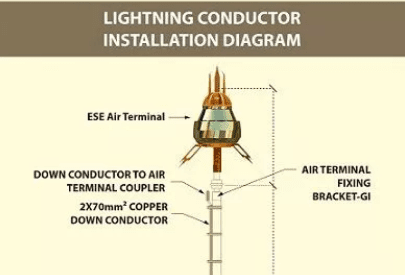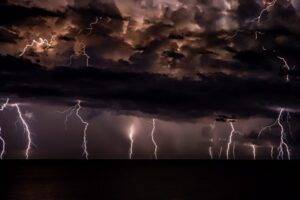What is a Lightning Conductor?
A lightning conductor is a thick copper wire or rod fixed onto the tallest point of a building and connected to the ground using a long metallic rod. It protects the building from lightning strikes by providing a low resistance path for the current to flow to the earth rather than through the building. In the event of a direct lightning strike, the current induced in the conductor may be so great that it melts the metal, but the damage to the building will be limited. Depending on structure, design and site condition there are different types of lightning conductors available, and each of them has a different installation procedure. Here we shall have a quick look at the installation process of a lightning conductor, which is part of a conventional lightning protection system.
Pre-requisites
- Before any electrical installation activity, ensure that the individuals involved with it strictly follow safety measures and procedures and use proper tools and personnel protective equipment.
- For installation of the lightning conductor on any structure, the location for the installation and height of the lightning conductor should be identified prior.
- The location should be at a height, on top of any structure or an open ground area.
- Check the feasibility of installation since the installation kit is as per the availability of space on the structure.
Free Book on ESE Lightning Arrester
Lightning Conductor Installation Steps
For Lighting conductors up to a height of 2 meters –
1) They can be directly mounted on the air terminal base (ATB).
2) Fix the air terminal base (ATB) on the parapet (of the structure) or at the identified location.
3) Fix the lightning conductor directly onto the ATB using a tightening rod if it is threaded, if it is not threaded it can be fastened using a fastener.
4) The down conductor must be fixed to the lightning conductor or onto the ATB, which is further connected to the earth termination system.
For Lightning conductors of height above 2 meters –
1) It requires a proper mast arrangement, including anchoring support.
2) Install the mast at the identified location.
3) The GI mast can be directly installed on the ground with a concrete foundation.
4) For the tripod-type mast, the concrete foundation should be as per the orientation of the tripod.
5) The mast is given anchorage support from 3 sides to protect it from wind impact.
6) A suitable adapter should be fixed on the mast so that lightning conductors can be directly fixed onto the adapter.
7) Fix the Lightning conductor onto the adapter directly using a tightening rod if it is threaded. If it is not threaded it can be fastened with help of a fastener.
8) Down conductor needs to be fixed onto the Lightning conductor which will be further laid to the earth termination system.
For different types of structures such as taper roofs, chimneys, tanks or pointed parts of a heightened structure etc., a suitable bracket shall be used for fixing the Lighting conductor.
The lightning conductor is an important part of the lightning protection system and should be installed following proper guidelines and requirements of the structure and geography of the location. The lightning protection system also needs regular inspection to ensure proper functioning for effective lightning protection.
Apart from the guidelines given above, if you want to learn more in detail about the standard procedures and requirements in the Lightning protection system, you can refer to IEC 62305 and NFPA 780.
Read more about Earthing & Lightning Protection
Surge Protection Devices (SPD)
Lightning Protection Zones and their Application to SPD Selection
How does a Lightning Arrester work?
Click here to view all of Axis’s Lightning Protection, Lightning Arresters and Earthing products.
Conclusion
Installing a lightning conductor is a crucial step in safeguarding buildings and infrastructure from the devastating effects of lightning strikes. By offering a controlled path for high-voltage discharge to safely reach the ground, these conductors significantly reduce the risk of fire, electrical surges, and structural damage. Whether mounted on residential buildings, industrial facilities, or open-area masts, proper installation in compliance with IEC 62305 and NFPA 780 standards ensures long-term protection and reliability. Regular inspection, appropriate material selection, and professional guidance are key to the success of any lightning protection system. For end-to-end support on your lightning conductor installation or to choose the right solution based on your site, reach out to our experienced engineering team today.
Thank you for reading the blog, Axis is a leading manufacturer and supplier of Electrical Components to over 80+ Countries. Talk to our industry expert by visiting our contact us section. You can also watch our videos by our experts – click here.








